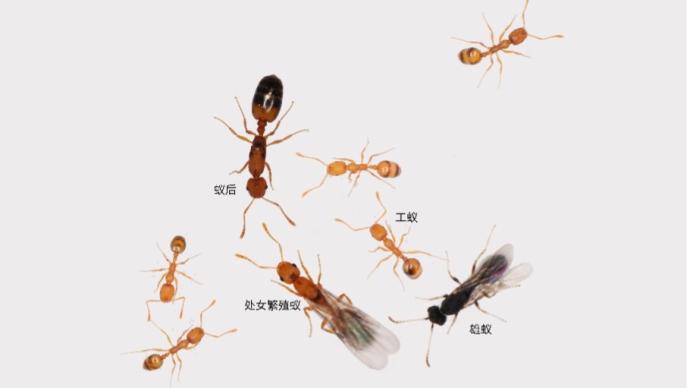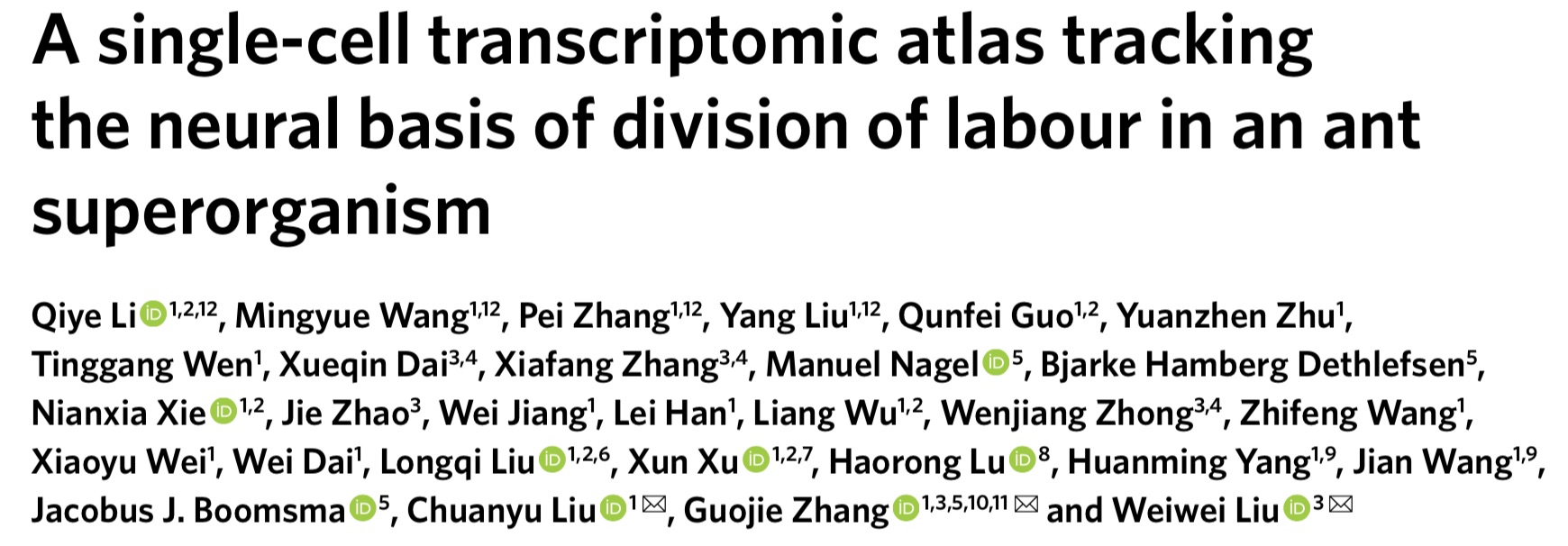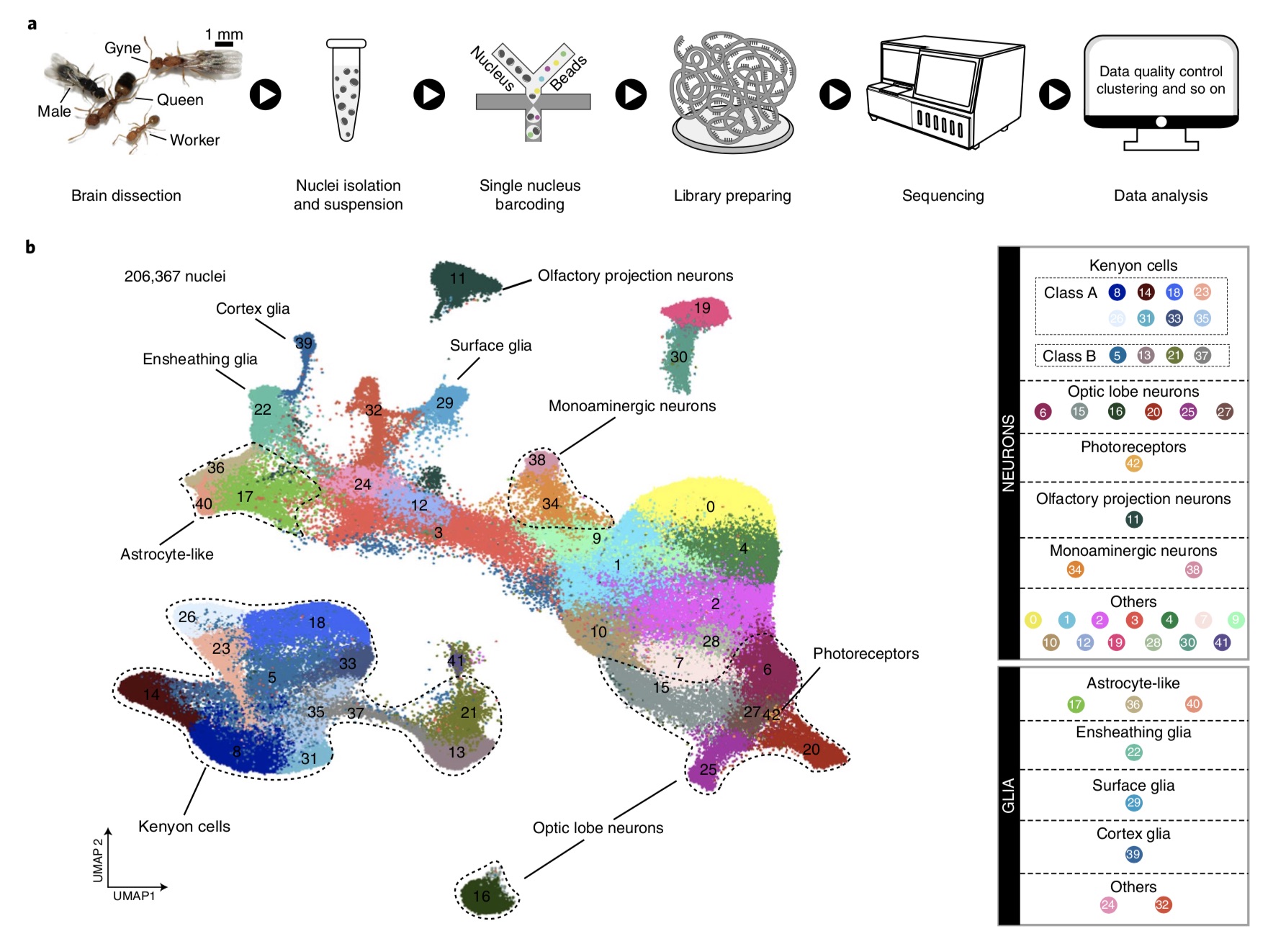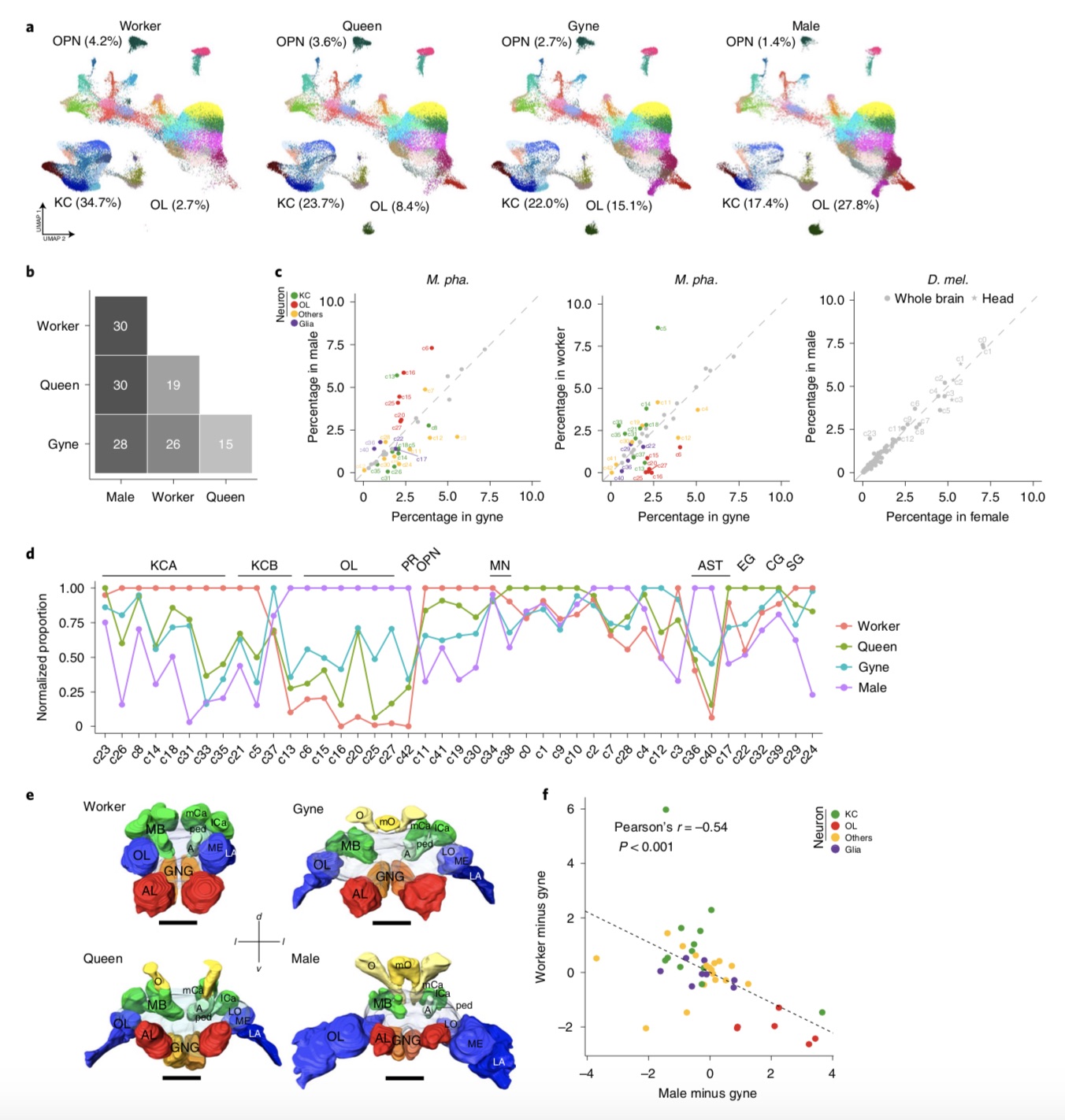
Ants that have survived on earth for 140 million years have coexisted with dinosaurs and witnessed the rise of mankind. A point of long-standing interest to the scientific community is that ants cannot survive alone, but must be part of a colony, and their evolutionary success is closely related to their high degree of socialization.
However, what are the relevant mechanisms behind the high socialization of ants? On the evening of June 16, teams from BGI Shenzhen, Kunming Institute of Zoology, Chinese Academy of Sciences, and Copenhagen University in Denmark published a study online in the international academic journal Nature Ecology & Evolution. The research team constructed brain cell atlases of four different grades of ants, revealing the neural basis of brain specialization and differences in behavior patterns of different social grades in ants along with social division of labor. The co-corresponding author of the paper, Professor Zhang Guojie, currently Qiushi Chair Professor at Zhejiang University and Director of the Life Evolution Research Center, pointed out that this work suggests that the specialization of the brain is the basis for the social division of labor and behavioral differences between different grades of ants.
The co-corresponding author of the paper, Professor Zhang Guojie, currently Qiushi Chair Professor at Zhejiang University and Director of the Life Evolution Research Center, pointed out that this work suggests that the specialization of the brain is the basis for the social division of labor and behavioral differences between different grades of ants.
Zhang Guojie concluded that these different but complementary brains support the ant colony to become a true "super-individual". Therefore, natural selection has also risen to a higher level of organization, enabling ants to gain an advantage in the 140 million-year survival competition and evolve into an extremely dominant animal group on the earth.
Generally speaking, in a mature ant empire, there are at least four different types of division of labor, namely: worker, male, gyne and queen. In this study, the research team selected the model species of social insect research, the pharaoh ant, as the research object. The pharaoh ant is a small, orange-yellow ant that is widely distributed around the world and is also a recognized indoor pest.
Based on BGI's DNBelab C4 single-cell library construction and sequencing platform, the research team analyzed more than 900 brains from 4 different grades of pharaoh ants, constructed a brain cell map covering all adult forms in the pharaoh ant society, and divided them into 43 different cell groups.
In this study, the researchers found that the brains of worker and male ants are extremely specialized. Among them, the mushroom body cells, which are responsible for learning and memory, and the cells responsible for processing odor information are very high in the brains of workers, while the optic lobe cells responsible for processing visual information are very low in the brains of workers. The male ant brains showed the opposite trend in cellular composition, with high levels of optic lobes and very low levels of mushroom body cells and cells that process olfactory information. The brain cell types of virgin breeding ants and queens were relatively "normal."
"This means that worker ants are more inclined to smell perception, while male ants rely more on vision, which may be related to the fact that they rely on vision to find suitable mating partners." Li Qiye, the first author of the paper and Shenzhen BGI Life Sciences Research Institute The researcher said, "Within the ant colony, there are brains with different structures and cellular compositions along with different social divisions of labor. These are like brains specially designed to perform specific tasks."
"At the overall level, the brains of different grades of ants have different directions and degrees of specialization, and they complement each other's functions, which makes the ant colony a true 'super-individual' that can simultaneously perform reproduction, child rearing, Foraging, defense and other comprehensive functions." The co-corresponding author of the paper and associate researcher Liu Weiwei of the Kunming Institute of Zoology, Chinese Academy of Sciences added.
The research team also compared differences in the brain cell composition of pharaoh ants and fruit flies. They found that mushroom somatic cells, which are responsible for higher cognitive functions, were more abundant in pharaohs than in fruit flies, and their functions were significantly differentiated. In addition, although pharaohs and fruit flies have been separated for hundreds of millions of years in evolutionary history, the study found that there are still many types of cells in their brains that maintain the same molecular characteristics and perform similar functions.
However, what are the relevant mechanisms behind the high socialization of ants? On the evening of June 16, teams from BGI Shenzhen, Kunming Institute of Zoology, Chinese Academy of Sciences, and Copenhagen University in Denmark published a study online in the international academic journal Nature Ecology & Evolution. The research team constructed brain cell atlases of four different grades of ants, revealing the neural basis of brain specialization and differences in behavior patterns of different social grades in ants along with social division of labor.
 The co-corresponding author of the paper, Professor Zhang Guojie, currently Qiushi Chair Professor at Zhejiang University and Director of the Life Evolution Research Center, pointed out that this work suggests that the specialization of the brain is the basis for the social division of labor and behavioral differences between different grades of ants.
The co-corresponding author of the paper, Professor Zhang Guojie, currently Qiushi Chair Professor at Zhejiang University and Director of the Life Evolution Research Center, pointed out that this work suggests that the specialization of the brain is the basis for the social division of labor and behavioral differences between different grades of ants.Zhang Guojie concluded that these different but complementary brains support the ant colony to become a true "super-individual". Therefore, natural selection has also risen to a higher level of organization, enabling ants to gain an advantage in the 140 million-year survival competition and evolve into an extremely dominant animal group on the earth.
Generally speaking, in a mature ant empire, there are at least four different types of division of labor, namely: worker, male, gyne and queen. In this study, the research team selected the model species of social insect research, the pharaoh ant, as the research object. The pharaoh ant is a small, orange-yellow ant that is widely distributed around the world and is also a recognized indoor pest.
Based on BGI's DNBelab C4 single-cell library construction and sequencing platform, the research team analyzed more than 900 brains from 4 different grades of pharaoh ants, constructed a brain cell map covering all adult forms in the pharaoh ant society, and divided them into 43 different cell groups.

Transcriptome classification of ant brain cell types.
Previous studies have shown that worker ants generally have completely degenerated ovaries and spend their entire lives engaged in child rearing, foraging, etc., without the ability to reproduce. Male ants have only one goal in life. They leave the nest to find their favorite queen to mate with. Life ends soon after mating. After the virgin breeding ants successfully mate, they become queen ants. The queen ants stay in the nest for a long time and lay eggs full-time, and her lifespan will be significantly prolonged after gaining the queen position. However, the behavior of virgin breeding ants who miss the mating window will gradually shift towards worker ants. Engaged in some child rearing and foraging work, and the ovaries will gradually shrink.In this study, the researchers found that the brains of worker and male ants are extremely specialized. Among them, the mushroom body cells, which are responsible for learning and memory, and the cells responsible for processing odor information are very high in the brains of workers, while the optic lobe cells responsible for processing visual information are very low in the brains of workers. The male ant brains showed the opposite trend in cellular composition, with high levels of optic lobes and very low levels of mushroom body cells and cells that process olfactory information. The brain cell types of virgin breeding ants and queens were relatively "normal."
"This means that worker ants are more inclined to smell perception, while male ants rely more on vision, which may be related to the fact that they rely on vision to find suitable mating partners." Li Qiye, the first author of the paper and Shenzhen BGI Life Sciences Research Institute The researcher said, "Within the ant colony, there are brains with different structures and cellular compositions along with different social divisions of labor. These are like brains specially designed to perform specific tasks."
"At the overall level, the brains of different grades of ants have different directions and degrees of specialization, and they complement each other's functions, which makes the ant colony a true 'super-individual' that can simultaneously perform reproduction, child rearing, Foraging, defense and other comprehensive functions." The co-corresponding author of the paper and associate researcher Liu Weiwei of the Kunming Institute of Zoology, Chinese Academy of Sciences added.

Specialization and complementarity of the pharaoh ant brain.
In addition, when the team compared the brains of virgin breeding ants with mature queens, they found marked changes in the composition of their brain cells. Among them, the content of optic lobe cells was significantly reduced in the queen's brain, which was related to the long-term adaptation of the queen to the dark nest environment. The content of dopamine cells and a type of neuroprotective glial cells was significantly increased in the queen brain. Changes in these brain cell populations and remodeling of neural circuits may determine the extreme improvement of reproductive function and a significant increase in lifespan of the queen. This also provides a possible direction for the study of longevity in other animals.The research team also compared differences in the brain cell composition of pharaoh ants and fruit flies. They found that mushroom somatic cells, which are responsible for higher cognitive functions, were more abundant in pharaohs than in fruit flies, and their functions were significantly differentiated. In addition, although pharaohs and fruit flies have been separated for hundreds of millions of years in evolutionary history, the study found that there are still many types of cells in their brains that maintain the same molecular characteristics and perform similar functions.
Related Posts
0 Comments
Write A Comments